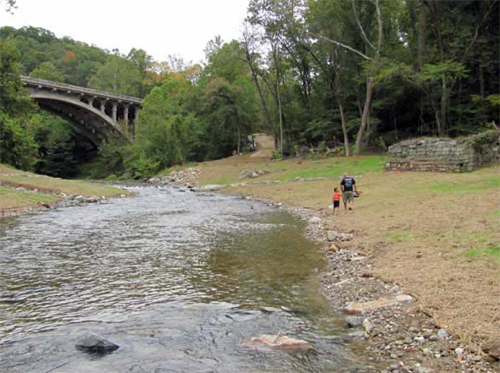Fish Passage Goals and Criteria
Main_Content
Prioritization Criteria for Fish Passage Projects in Maryland
There are over 2,500 manmade blockages in the Chesapeake Bay watershed that inhibit migratory and
 resident fish from reaching their spawning habitat. The loss of habitat has impacted population numbers of many fish species. While there have been improvements in opening historic spawning habitat through the successful completion of the 2003 Fish Passage Goal which opened approximately 1300 miles of river habitat, continued effort was warranted. The Chesapeake 2000 Agreement recognized the importance of providing additional habitat for migratory and resident fish by committing to the development of a new Fish Passage goal. A major component of a "healthy" Bay ecosystem is abundant fish populations through habitat restoration and protection.
resident fish from reaching their spawning habitat. The loss of habitat has impacted population numbers of many fish species. While there have been improvements in opening historic spawning habitat through the successful completion of the 2003 Fish Passage Goal which opened approximately 1300 miles of river habitat, continued effort was warranted. The Chesapeake 2000 Agreement recognized the importance of providing additional habitat for migratory and resident fish by committing to the development of a new Fish Passage goal. A major component of a "healthy" Bay ecosystem is abundant fish populations through habitat restoration and protection.
Therefore the Chesapeake Bay Program signatory partners adopted the Fish Passage Goal as follows:
During the period 2005-2014, Chesapeake Bay jurisdictions will complete 100 fish passage and/or dam removal projects, which will open 1,000 miles of high quality tributary habitat to migratory and resident fishes. Actual fish utilization and passage will be documented at all new fish passage projects and, wherever possible, these projects will be integrated within locally supported watershed management or restoration plans.
Priority will be given to:
- Projects which open larger stretches of highest quality habitats
- Complete dam removals as opposed to structural fish passages, where practical
- Projects which enhance passage of migratory fish over resident fish and/or where shad and herring stocking programs occur
- Removal of impediments in streams formerly impaired by acid mine drainage (AMD) where water quality improvements will support a diverse assemblage of fish and other aquatic resources
In addition, projects in Maryland will be prioritized under the following guidelines:
- Dam removals are favored over fish passage construction. Dam removals are favored over other forms of fish passage construction when feasible, since they completely restore a stream to its natural state and provide for free passage up and down river for all aquatic organisms.
- When fish passage is necessary, natural fishways and by-pass channels are favored over traditional fish ladders. Traditional fish ladders may still be the only alternative for select sites. However, before a fish ladder design is selected there are a number of issues that need to be addressed:
- Guarantee of an institutional sponsor for long term operation and maintenance, including a budget dedicated for this purpose.
- Ease of access & costs for maintenance
- Potential & frequency of blockage by debris and sediment,
- Creation and maintenance of attraction flows for upstream migrants,
- Range of effective flows and seasonality of migrations for all target species,
- Predation and lack of suitable nursery habitat for larval and juvenile migrants in the impoundments
- Introduction of non-native or undesirable species to upstream habitat
- Potential success of downstream migration
- Projects will be prioritized based on the amount and quality of habitat reopened. E.g., projects which reopen habitat in forested/buffered areas will be favored over projects in urban or poor water quality areas.
- Assuming projects have the support of the landowner, projects are prioritized as follows, in association with the above general guidelines:
- Diadromous and/or Rare, Threatened or Endangered (RTE) species found below the blockage and suitable habitat upstream of the blockage. Projects can be ranked further based on the diversity and quantity of anadromous and/or Rare, Threatened or Endangered species found below the blockage. Projects which pass anadromous fish into lake or pond environments will not be recommended until research in the Chesapeake Bay watershed shows successful spawning in these lake/pond environments. Note: projects which block hosts for Rare, Threatened or Endangered species will be listed here (ex. fish carrying mussel larvae).
- Resident game species (trout, bass, walleye, etc.) found below the blockage and suitable habitat upstream of the blockage.
- Projects which block historical anadromous fish habitat (but anadromous fish not present) and suitable habitat upstream. Watersheds with active or proposed stocking programs will be favored over watersheds without such programs.
- Projects blocking resident fish only, no anadromous, Rare, Threatened or Endangered species, or game species present. These projects will be prioritized in this order:
- Quality and Quantity of habitat to be reopened
- Diversity of species found below the blockage
- Amount of outside funding available for the project, and community support for the project.